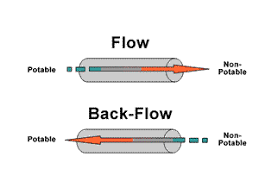Backflow / Cross Connection: Why Do They Matter?

What is a Cross Connection?
A cross connection is a point in a plumbing system where the potable water supply is connected to a non-potable source. Briefly, a cross connection exists whenever the drinking water system is or could be connected to any nonpotable source (plumbing fixture, equipment used in any plumbing system). When a cross connection is not carefully controlled, pollutants or contaminants can enter the safe drinking water system causing backflow to occur.
What is Backflow?
Backflow is the unwanted flow of non-potable substances back into the consumer’s plumbing system and/or public water system (i.e., drinking water). There are two types of backflow: backsiphonage and backpressure. Backsiphonage is caused by a negative pressure in the supply line to a facility or plumbing fixture. Backsiphonage may occur during waterline breaks, when repairs are made to the waterlines, when shutting off the water supply, etc.
Backpressure can occur when the potable water supply is connected to another system operated at a higher pressure or has the ability to create pressure, etc. Principal causes are booster pumps, pressure vessels, elevated plumbing, etc.
Backflow preventers are mechanical devices designed to prevent backflow through cross connections. However, for backflow preventers to protect as designed, they must meet stringent installation requirements.
Why do they matter?
Cross Connection and Backflow are so important because they could introduce dangerous substances into the safe drinking water system. All water utilities work hard to meet high standards of safety in order to protect public health from backflow due to cross connection.
 Contact Us
Contact Us